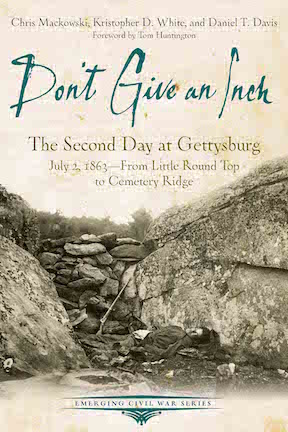Don’t Give an Inch is “one big adrenaline rush”
 Emerging Civil War’s latest book about Gettysburg tells the story of a battle hailed as “one, big adrenaline rush” by one of the book’s co-authors.
Emerging Civil War’s latest book about Gettysburg tells the story of a battle hailed as “one, big adrenaline rush” by one of the book’s co-authors.
Don’t Give An Inch: The Second Day At Gettysburg, July 2, 1863—from Little Round Top to Cemetery Ridge, co-written by Chris Mackowski, Kristopher D. White, and Daniel T. Davis, focuses on two main themes: the faults in the Confederates’ plan and the fury Confederate Gen. James Longstreet brought into the battle, despite his apparent disapproval of the plan.
Along with their focus on these topics, the book’s authors also aimed to debunk long-standing misconceptions regarding the second day at Gettysburg—which White and Davis said are usually created and continued by popular culture.
The two added that Michael Shaara’s novel The Killer Angels and films such as Gettysburg and Gods and Generals have aided in covering up lapses in successful leadership during the battle.
“Shaara’s focus on July 2 is primarily on [Union Brig. Gen.] Joshua Chamberlain and the 20th Maine fighting at Little Round Top,” Davis said. “And when that was translated into the film Gettysburg in 1992, all of a sudden Joshua Chamberlain became the focal point.”
Chamberlain’s reputation is largely overblown, White and Davis explained. White added that he refers to Chamberlain as the “greatest used car salesman in American history.”
“[The biggest misconception is] that the 20th Maine and Joshua Lawrence Chamberlain saved the Union on Little Round Top,” White said. “Chamberlain is one the largest braggarts I have come across in either army. He was well educated and trained in rhetoric. . . . After the war, his second-in-command at Gettysburg called him out on his fanciful storytelling, calling Chamberlain’s book ‘The Passing of the Armies, a tissue of lies.’ Chamberlain’s ego grew exponentially in the postwar years and turned many of his former comrades against him.”
Aside from analyzing Chamberlain, the book focuses on the action happening on the other side of the hill, too.
“We change the focus from Chamberlain and the 20th Maine, who’s really on the southern end of Little Round Top, and also talk about what’s going on at the other side of the hill—above him—and the key individuals who were involved in the fighting on the other end of the line,” Davis said.
In typical Emerging Civil War fashion, the work focuses heavily on the battle’s action, as well, It provides a look at not only Little Round Top, but Devil’s Den, the Wheatfield, Peach Orchard and Cemetery Ridge.
“The chapters themselves follow the flow of the action from endangered point to endangered point,” White said. “There really is no low point in the battle, so the story flows from one exciting story to the next.”
Of course, putting together a comprehensive piece wasn’t an easy feat; however, White and Davis said the intensive research these pieces require was alleviated by their long-standing love for Gettysburg.
White, a former member of The Association of Licensed Battlefield Guides, found his early interest in the often-misunderstood battle in the Wheatfield while reenacting with the 140th Pennsylvania in high school. This helped develop his understanding of Gettysburg and the war at large, he explained.
White’s research on Gettysburg began far before he and his co-authors began talking about writing a piece on the battle. As a result, very few accounts had to be collected after they decided to write the piece.
“From my teenage years to my early 20’s, I bought any book, magazine [and] journal that I could find,” White said. “As I entered college and learned how to be a historian, I moved on to collecting regimental histories, letters [and] diaries.”
Davis agreed and said the research that went into Don’t Give An Inch was “consistent with what [he’d] done in the past.”
“It’s a story many Civil War students start off on,” Davis said. “So, I’ve been going through it since I was very young. I’ve read many of the major campaign studies on Gettysburg.”
“A lot of people wonder, ‘Do we need another book on Gettysburg,’” White admitted.“But the fact is, people keep reading them.” Don’t Give an Inch differs from others because of its approach.“The trend in publishing is to get more and more focused on smaller and smaller components of the battle,” White explained.“We saw room for a book that provides a good overview for people without being too vague and without buying into a lot of the old familiar—but wrong—stories.”
Both White and Davis added that the piece includes nearly 150 pictures, which White said “allows the reader to see the field from the couch” and Davis said serves as “an unofficial battlefield buddy” for those visiting Gettysburg. The book also includes ten original maps by Hal Jespersen and a foreword by Gettysburg historian Tom Huntington.
nice website, thanks for sharing 🙂
the war is a sad event that everybody wants no in seconds
dont war again. this is truly heart breaking